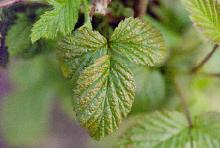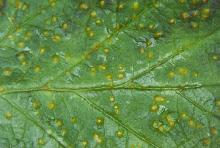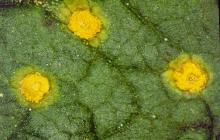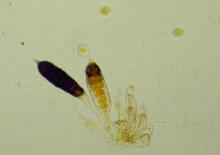See:
Raspberry Cultivar Susceptibility
Cause Phragmidium rubi-idaei, a fungus widespread in red raspberry in western Oregon and Washington, particularly in years when spring rains continue late. Historically, rust has not been a problem in the 'Canby', 'Chilcotin' 'Newburgh', 'Puyallup', or 'Sumner' cultivars. However, new races are in the Pacific Northwest that will infect cultivars previously resistant, such as Meeker and Willamette.
The fungus overwinters as teliospores on leaves. When infected leaves are trapped between canes, when they are tied to the top trellis wire, the fungus starts the disease the following spring at the top of the plant.
Symptoms Leaf infections in spring and early summer create a yellowish spotting on the upper leaf surface. At first the spots are very small, yellow to orange and slightly raised (spermagonia) but then new, yellow to orangish spore bearing structures (aecia) are produced in a ring around these spots. By summer, another yellow spore stage (uredinia) appears on the lower leaf surface. Some of these structures could be described as "orangish," without a good comparison. Fruit often dies on the canes before maturing if leaves on fruiting laterals are attacked early in the summer. By harvest, black overwintering spores (teliospores) appear in the yellow uredinia on the lower leaf surface. Defoliation of severely infected leaves is common. All succulent plant parts are subject to infection, but cane lesions rarely are observed. Infected canes often are brittle and may break off when old fruiting canes are pruned out.
Cultural control
- Burying fallen leaves, old cane stubs, and refuse before new leaves appear will help eliminate inoculum sources.
- In home gardens, destroy fallen leaves and other refuse.
- Remove and burn old fruiting canes as soon after harvest as possible, cutting flush with the ground. Cultivate as soon as weather permits.
- Strip leaves from primocanes before tying.
- Postpone trellising primocanes until leaves drop off.
- Primocane suppression eliminates susceptible tissues when rust spores are present on fruiting cane leaves.
- Control cane vigor to improve air circulation in the plant canopy, which hastens drying of leaves and canes.
Chemical control
- Delayed dormant application. Wait until the first buds produce about 0.75 inch of new growth.
- Bordeaux 8-8-100. O
- Many different fixed copper products are registered but of unknown efficacy.
- Rex lime sulfur (28%) at 6 to 12 gal/100 gal water. 48-hr reentry. O
- Sulforix at 3 gal/100 gal water. 48-hr reentry.
- When new growth is 3 to 4 inches and again when the first flowers are just about to open.
- Abound at 6 to 15.5 fl oz/A. Do not apply with silicone-based surfactants. May be applied on the day of harvest. Group 11 fungicide. 4-hr reentry.
- Cinnerate at 16 to 64 fl oz/100 gal water plus an adjuvant. 4-hr reentry. O
- EcoSwing at 1.5 to 2 pints/A. Can be used day of harvest. Group BM01 fungicide. 4-hr reentry. O
- Fontelis at 14 to 24 fl oz/A. Can be used day of harvest. Group 7 fungicide. 12-hr reentry.
- Quadris at 6 to 15.5 fl oz/A. Do not apply with silicone-based surfactants. May be applied on the day of harvest. Group 11 fungicide. 4-hr reentry.
- QuiltXcel at 14 to 21 fl oz/A. Do not use within 30 days of harvest. Sprayers should not be used on apples. Group 3 + 11 fungicide. 12-hr reentry.
- Rally 40 WSP at 1.25 to 3 oz/A. Applications may be made up to the day of harvest. Group 3 fungicide. 24-hr reentry.
- Spectracide Immunox Multi-Purpose Fungicide Spray Concentrate for Gardens at 0.67 fl oz/gal water. May be applied up to the day of harvest. Group 3 fungicide. H
Note: Some registered products offer only suppression of this disease and thus are not recommended for use. These products include Cabrio and Pristine.
References Anthony, V.M., Shattock, R.C., and Williamson, B. 1985. Life-history of Phragmidium rubi-ideai on red raspberry in the United Kingdom. Plant Pathology. 34:510-520.
Bristow, P. R., and Derie, M. 1995. Reaction of red raspberry genotypes to isolates of yellow rustfungus by leaf disk assay. B & C Tests, APS Press 10:57.
Pârlici, R. M., Maxim, A., Mang, S. M., Camele, I., Mihalescu, L. and Stoian, V. 2021. Alternative Control of Phragmidium rubi-idaei Infecting Two Rubus Species. Plants, 10:1452; https://doi.org/10.3390/plants10071452.






